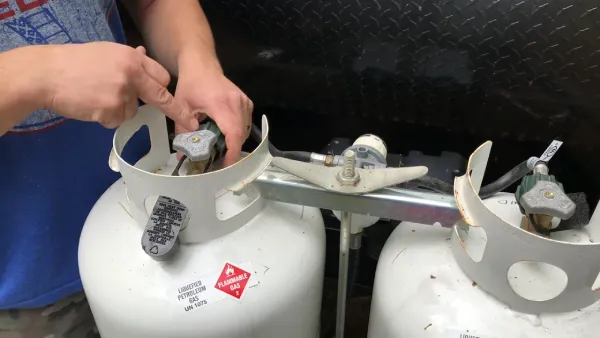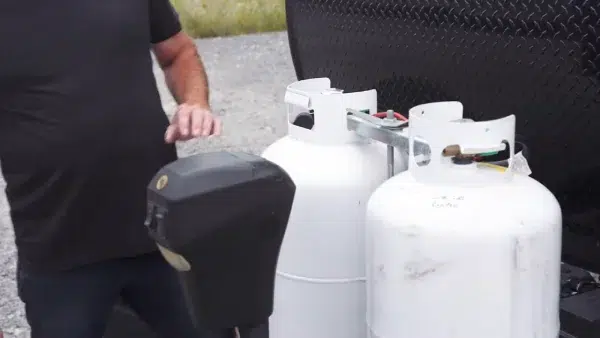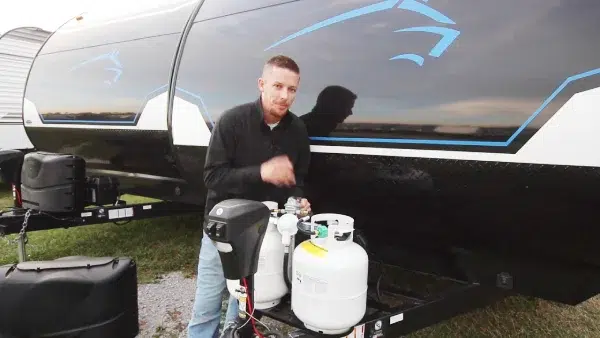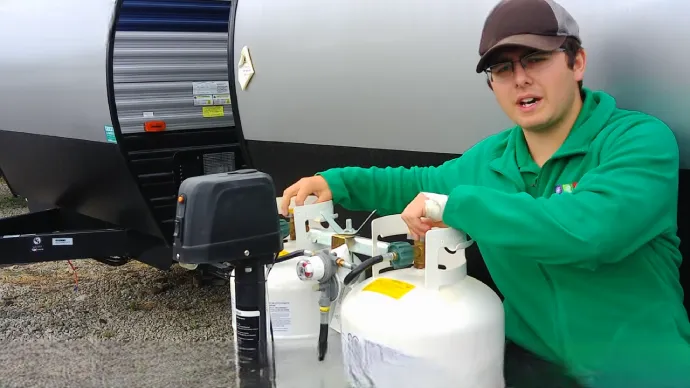Last Updated on May 18, 2023
As a responsible RV owner, you understand the importance of managing your propane tanks to ensure safe and efficient operation. One question frequently arises is whether you need to open both propane tanks on your RV. The answer is yes, it’s best to open both tanks when using an automatic changeover setup.
This way, you can ensure a steady propane supply, as the tanks are connected to the regulator and the propane flows uninterrupted. Failing to open both tanks can create unnecessary complications and even pose a risk.
Learn how to properly manage propane tanks for your RV, and discover the importance of opening both tanks for optimal usage. Don’t miss out on this essential information.
Why Do You Open Both Propane Tanks On RV: 3 Reasons

Using both propane tanks on your RV is smart for several reasons. By opening both tanks, you can ensure that you have enough fuel supply for all your needs, prevent uneven tank consumption, and avoid running out unexpectedly.
#One: Ensuring Sufficient Fuel Supply
Opening both propane tanks on your RV ensures that you have twice the amount of fuel available. This is especially important if you plan on taking long trips or if you’re traveling to areas where propane refills may not be readily available.
It’s important to note that even if one tank runs out of gas, the other tank will still provide a continuous supply of propane until it’s completely empty. This means that you won’t have to worry about running out of gas while cooking dinner or taking a hot shower.
In addition to providing peace of mind, opening both propane tanks also helps prevent uneven tank consumption. By using both tanks equally, you can avoid one tank running dry while the other still has plenty of gas left.
#Two: Preventing Uneven Tank Consumption
When using propane tanks on your RV, it’s important to ensure that both tanks are being used evenly.
Uneven tank consumption can lead to one tank running out of gas while the other tank still has plenty left. This can be inconvenient and potentially dangerous if you rely on propane for cooking, heating, or other essential functions.
To prevent uneven tank consumption, you can do a few things. The first is to ensure that both tanks are turned on and used simultaneously. This means that both valves should be open and connected to your RV’s propane system.
Another way to prevent uneven tank consumption is to switch between the two tanks regularly. Many RVs have an automatic switch-over valve that automatically switches from one tank to another when the first tank runs out of gas.
However, if your RV doesn’t have this feature, you’ll need to switch between the two tanks manually.
The two tanks can be switched manually, simply turn off the empty tank and turn on the full one. This will allow you to use all of the propane in one tank before switching to the other. It’s a good idea to keep an eye on how much propane is left in each tank so that you don’t run out unexpectedly.
#Three: Reducing the Risk of Running Out of Gas
Propane is an essential fuel source for many RVers, and running out of gas while on the road can be a frustrating and potentially dangerous experience. One way to reduce gas runouts is by venting both propane tanks on your RV.
By opening both tanks, you ensure that you have a sufficient fuel supply for your appliances and other propane-powered devices. This is especially important during extended trips when refilling may not be possible.
Keeping both tanks open prevents uneven consumption. When only one tank is in use, it can become depleted faster than the other, leading to an imbalance that can disrupt your propane system’s proper functioning. By alternating between tanks or using them simultaneously, you ensure that they are used evenly.
Ensuring you don’t run out of gas is crucial because it can lead to several issues, including disrupted travel plans, inconvenience, and potential safety hazards. For example, running out of gas while cooking could result in undercooked food or even a fire hazard.
How to Safely Open Both Propane Tanks on RV?

If you’re using propane tanks to fuel your RV, knowing the proper way to open and maintain them is essential. Here are some simple steps to ensure a steady fuel supply and prevent accidents.
Step 1: Turn Off All Appliances and Ignition Sources
Before opening both RV tanks, taking some safety precautions is essential. One of the first steps is turning off everything. This includes stoves, heaters, and anything that uses propane.
Turning off these appliances and ignition sources reduces the risk of a fire or explosion. Propane is a highly flammable gas, so taking this step seriously is crucial.
Once you’ve turned off all appliances and ignition sources, you can move on to opening the propane tanks. It’s essential to close the valves on both tanks before opening them. Then, open each valve slowly while checking the leak with soapy water.
Step 2: Close the Valves on Both Propane Tanks
To ensure safe operation and prevent gas leaks, it is essential to shut off the valves when they are not in use. This will prevent any propane from escaping and posing a potential hazard.
Closing the valves on both tanks also helps to preserve the lifespan of your RV’s propane system. When the valves are closed, it prevents any pressure buildup in the hoses or fittings, which can cause wear and tear over time.
It is recommended that you close the valves on both tanks whenever you are not using them, such as when you are driving or storing your RV for an extended period. This will help ensure that your propane system remains in good condition and is ready for use when needed.
When closing the valves on your propane tanks, ensure all appliances and ignition sources are turned off. This includes stovetops, ovens, heaters, and anything else that uses propane as a fuel source.
To close the valve on each tank, turn it clockwise until fully closed. You may want to double-check that each valve is entirely closed by gently trying to turn it further after it stops moving.
Step 3: Slowly Open One Valve at a Time
When you’re ready to use your RV’s propane system, start by turning off all appliances and ignition sources. This is crucial to prevent any sparks or flames from igniting the propane gas as you work with the tanks.
Next, close the propane tanks tight. Make sure they are completely closed before moving on to the next step.
Now comes the critical part: slowly opening one valve at a time. This is necessary to ensure no sudden rush of propane gas could cause an explosion or fire. It also helps to prevent damage to your RV’s propane system.
To begin, choose one of the two propane tanks and turn its valve counterclockwise just a little bit. You should only turn it about a quarter of a turn at first, then wait for a few seconds before turning it further. Keep turning gradually until you hear gas flowing through the lines.
Once you’ve established that gas is flowing properly from this tank, repeat the process with the other tank. Remember only to turn each valve slowly and gradually, waiting for a few seconds between each turn.
After both valves are open and you’ve confirmed that gas flows correctly from each tank, check for leaks using a soapy water solution. Apply soapy water around all fittings and connections in your RV’s propane system – if there are any leaks, bubbles will form where the gas is escaping.
Step 4: Check for Leaks Using Soapy Water Solution
One of the most important steps in checking for leaks is to use soapy water to check for leaks. This step ensures no gas leaks, which can be dangerous and potentially lead to explosions.
You will need a mixture of soap and water to check for leaks. Mix the solution in a spray bottle and spray it over all the connections and valves on both propane tanks. If there is a leak, bubbles will form at the site of the leak.
It’s important to note that even small leaks should not be ignored, as they can quickly become larger and more dangerous. If you find a leak, turn off the propane supply immediately and repair it before using your RV’s propane system again.
Regularly checking for leaks is crucial in maintaining your RV’s propane system. Inspecting and replacing old hoses and fittings regularly is important, as these can wear out over time and cause leaks or other issues.
How to Maintain a Propane System in Your RV Safely and Efficiently?

Proper RV propane system maintenance is critical to ensure your vehicle’s safety and efficiency. Here are some essential tips to keep in mind:
- Regularly inspect and replace old hoses and fittings: Over time, hoses and fittings can become worn or damaged, which can lead to leaks or malfunctions in your propane system. Regularly inspecting and replacing these components is important.
- Store propane tanks in a cool, dry place: Propane tanks should be stored upright in a well-ventilated area away from heat sources, direct sunlight, and other flammable materials. This will help prevent damage to the tanks and reduce the risk of fire or explosion.
- Keep the tank valves closed when not in use: When you’re not using your RV’s propane system, close both tank valves tightly. This will help prevent gas leaks and ensure your tanks don’t deplete over time.
Are RV Propane Tanks Switched Automatically If Both Are Open?
Never worry about running out of propane while on the road. If an auto-switching valve is installed in your RV, it will switch to the propane tank with fuel. Whether you have one or two tanks, this feature ensures a constant flow of propane to your appliances without any manual intervention.
You must manually switch over to the other tank if you have a manual switching valve. But did you know that installing an auto-switching valve can offer more convenience and decrease the risk of running out of propane unexpectedly? Make your life easier and consider upgrading today.
Also, RV owners should conduct regular inspections and maintenance on their propane systems for maximum performance and safety.
How Many Turns Should You Open An RV Propane Tank?
To ensure a secure seal, opening the propane tank valve is crucial. However, one full turn counter-clockwise is sufficient when it comes to releasing the gas. It is advisable to turn the valve in only one rotation for safety reasons, making it easier to quickly turn off the gas in case of any unexpected problem.
This approach minimizes the chances of any mishaps and ensures that propane is released in a controlled manner. By following these guidelines, you can operate your RV propane tank without risking injury or damage to your equipment.
Don’t Hit the Road Unprepared: Open Both Propane Tanks
For any RV enthusiast, preparing before hitting the road is always important. One simple but crucial step is to open both propane tanks. Not only does this ensure enough supply for your journey, but it can also prevent uneven consumption between tanks and the potential headache of running out of gas mid-trip.
Always remember to shut off all appliances before opening the valves and to inspect and replace hoses and fittings regularly. Following these easy precautions, you can maintain a safe and reliable propane system for all your outdoor adventures.
So, confidently open those valves and hit the road with peace of mind knowing that you’re well-prepared for the journey ahead.



